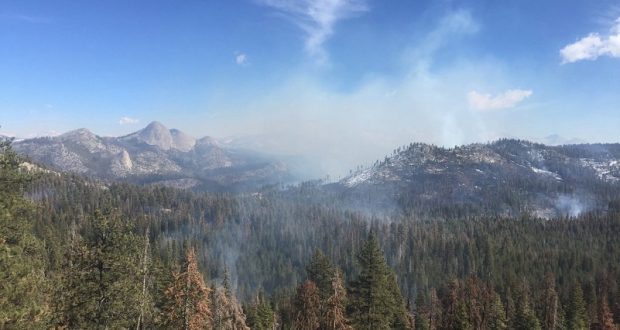YOSEMITE — Five fires continue to burn in the wilderness areas of Yosemite National Park, with a strong stable air mass over the area bringing warmer than normal temperatures and lower humidity.
This has contributed to more fire activity and more smoke production as the 8,000-acre Empire Fire moved through some heavier fuels. The smoke has been flowing into Yosemite Valley and is unable to lift out due to the stagnation.
There was a brief respite last Friday and Saturday, but the warm pattern is expected to continue throughout the week.
There is potential for periods of heavier smoke to occur during certain times in Yosemite Valley throughout this warm trend. Dense smoke can aggravate symptoms for sensitive persons and activity should be reduced or avoided.
Fire Managers are working with the local Air Quality Districts and will be monitoring smoke impacts to the park and local communities, say park officials.
Current fires in Yosemite National Park:
Empire
Discovered: 7/31/17
Location: 1 mile east of Yosemite Ski and Snowboard Area and 3/4 mile south of Glacier Point Road
Size: 8,094 acres
Cause: Lightning
Containment: 85%
Fuels: Red fir
The fire is moving east deeper into the wilderness, burning into the old “Meadow Fire” footprint in the Illiouette drainage producing moderate smoke. This area has shrubs and heavier dead and down fuel. The trajectory of the fire will likely take it in the direction of sparser fuels later in the week, which should reduce smoke production. The fire is visible from vistas along the Glacier Point Road.
South Fork
Discovered: 8/13/17
Location: .75 miles east of the community of Wawona
Size: 7,564 acres
Cause: Lightning
Containment: 90%
Fuels: Mixed conifer and red fir
The fire remains quiet near the community of Wawona on the west and south flank. Sections of the north flank and the entire east flank are continuing to burn into the wilderness. Fire activity has been minimal this week.
Starr King
Discovered: 8/2/17
Location: N 37° 42.965′ x W 119° 29.588′ at approximately 7,800 feet elevation
Size: 70 acres
Cause: Lightning
Spread Potential: Low/ Moderate
Fuels: Red fir/ Lodgepole Strategy: Monitor
Visible from the Glacier Point Road.
Porcupine
Discovered: 8/2/17
Location: N 37° 49.336′ x W 119° 34.720′ at approximately 8,154 feet elevation off Tioga road.
Size: 9 acres
Cause: Lightning
Spread Potential: Low
Fuels: creeping, burning in duff and dead and down in Lodgepole Pine/ Red fir
Strategy: Monitor
Visible burning next to the Tioga Road.
Ribbon
Discovered: 9/26/17
Location: 37 45.3 by119 38.5 at approximately 8,154 feet elevation off Tioga Road.
Size: 2 acres
Cause: Lightning
Spread Potential: Low
Fuels: Low brush
Strategy: Monitor
Visible from Sentinel Dome and Glacier Point
These fires are burning in designated wilderness. Lightning-ignited fires in wilderness areas are often allowed to burn if they do not threaten developed areas.
“The Yosemite Wilderness is a fire adapted ecosystem where past fire suppression has resulted in unnaturally high fuel levels,” say fire officials. “Allowing fires to burn unimpeded produces a healthier, more diverse forest and helps reduce the severity of future fires.”
For more information on Yosemite fires, visit https://www.nps.gov/yose/blogs/fireinfo.htm



